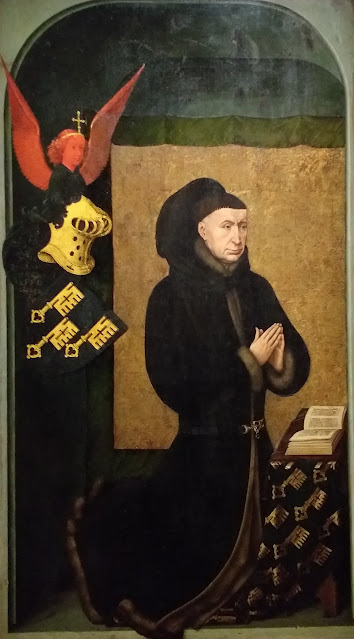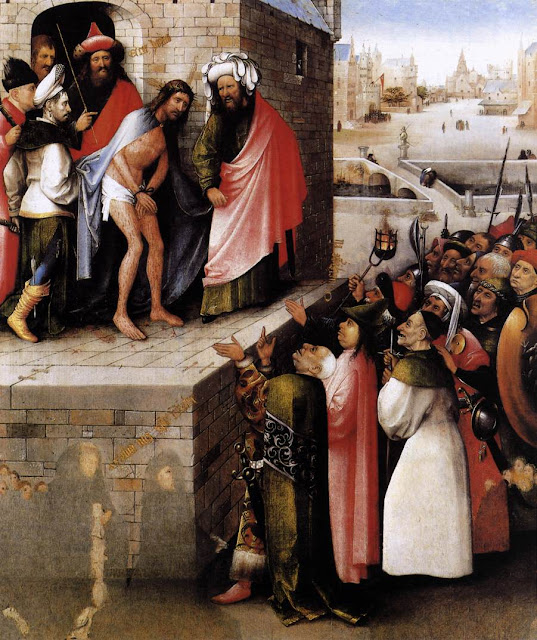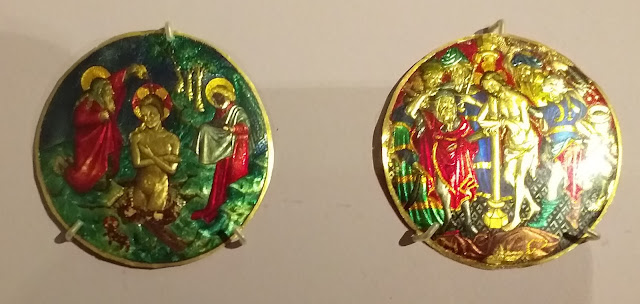 |
| Jan van Eyck: La vierge du chancelier Rolin (The madonna of Chancellor Rolin) ca 1430? |
This small exhibition at the Louvre has been put on to present the newly restored oil painting by Jan Van Eyck (1390?-1441) "The Madonna of Chancellor Rolin". Layers of darkened varnish have been stripped away to reveal its rich colours. The work represents the 15th century chancellor of Burgundy in devotion to the virgin Mary and child. Nicolas Rolin acted as chancellor for the powerful duke of Burgundy, Philip III the Good who reigned as Duke of that rich province from 1419 until his death in 1467. During his reign the Burgundian state reached its apex of prosperity and prestige and Philip's rule stretched up to the Netherlands.
Round the back of the the painting there is a helpful video presentation blowing up lots of background details.
Does the little man in the red turban represent the painter himself? Jan van Eyck once portrayed himself wearing such a turban. White lilies refer to the virgin Mary's purity. The Christ child has a weary wise look about him as he blesses the chancellor:
Behind Chancellor Rolin's dirty fingernails there is a whole town in the distance with people and horses:
Tiny people are to be seen on the bridge and boat:
Jan Van Eyck, portrait painter to the duke of Burgundy, had the skills of a miniaturist, working with a very fine brush, even a single hair. He manipulated the lighting in his pictures by using thin layers of oil paint.
Duke Philippe was a great patron of the arts; the court of Burgundy set the taste in Europe. As well as employing Jan van Eyck as court painter, the duke purchased over 600 manuscripts. A manuscript on show contains a portrait of the duke of Burgundy (the slim one in black):
 |
| Miniature by Rogier van der Weyden: Philip the Good receiving Jean Wauquelin's book 1447-48 Bruxelles, Bibliothèque royale de Belgique |
Chancellor Rolin, in blue, stands at his right hand. The Chancellor wears the same stern expression as in the big painting by Van Eyck:
 |
| detail |
Philip is mostly remembered for having captured Joan of Arc in 1430 and sold her to the English, enemy at the time of Charles VII of France. Rolin's great charitable work was founding the Hospices in Beaune. A panel of the famous altarpiece by Van der Weyden in the hospital shows the chancellor kneeling in prayer:
 |
| Rogier van der Weyden: Nicolas Rolin en prière (Nicolas Rolin in prayer) ca 1443-51 Hospices de Beaune |
Prominently displayed in the top left corner are Nicolas Rolin's arms: 3 golden keys and a helmet, presented by an angel.
A copy of a Rogier van der Weyden work has a similar set-up to the main exhibit of Rolin and Madonna. In this painting, Rolin is replaced by Saint Luc and the positions are reversed:
 |
| After Rogier van der Weyden: Saint Luke drawing the Virgin and Child ca 1500 Bruges Groeningemuseum |
The original van der Weyden, dated around 1435, may be seen in the Boston Museum of Fine Arts.
This exhibition allows us to compare the oil paintings on wooden panels with examples of manuscript illustrations from the same period- the 15th century. The following manuscript, loaned from Chambéry, contains an exquisite peacock, a symbol of renewal and eternal life:
 |
| Belbello da Pavia: Bréviaire franciscain de Marie de Savoie, Milan ca 1434 |
The three great Flemish artists of the 15th century were Robert Campin and his pupils Jan van Eyck and Rogier van der Weyden. Artists of their school made realistic portraits:
.jpg) |
| Portrait of a man ca 1440 School of Robert Campin Madrid, Museo Nacional Thyssen-Bornemisza |
The anonymous man above sports a hairstyle that would not be out of place nowadays on a football pitch! His expression is concentrated, almost anxious.
Jan van Eyck did a strikingly realistic portrait of another dignitary of the Burgundy court, wearing the Order of the Fleece on his chain:
.jpg) |
| Jan van Eyck: Portrait of Baudouin de Lannoy after 1431 Oak |
The chivalric Order of the Fleece was created by Philip the Good in 1430.
In the realm of the ideal, exquisite portrayals of the madonna and child are on show, like the following anonymous one from the Cologne school:
 |
| Anon. painter active in Cologne: Virgin and Child in a Meadow walnut wood ca 1420-25 |
A further portrayal of the Madonna and Child is set in the garden of paradise by the master of Saint Laurent, active in Cologne from 1415 to 1430:
 |
| Maître de Saint Laurent: Vierge dans un jardin de paradis (Madonna in a Garden of Paradise) ca 1410-1420 Oak Cologne Wallraf-Richartz Museum |
The art of Cologne was familiar to Jan van Eyck. He painted a sumptuous angel Gabriel, seen against a fantasy background in an annunciation scene:
.jpg) |
| Jan van Eyck Annunciation ca 1435? Washington National Gallery, Mellon Collection |
The multi-coloured-winged angel Gabriel smiles gently:
Contrasting with Netherlandish artists and their detailed realistic style, the exhibition displays an Italian virgin and child by Jacopo Bellini, with an ideal cosmos behind them :
 |
| Jacopo Bellini: The Virgin of Humility adored by a prince (Lionello?) of the House of Este |
An Ecce Homo provides a sobering contrast to all the portraits of baby Jesus- a later 15th century work by Hieronymus Bosch- where Pontius Plate is showing Christ to a hostile crowd:
 |
| Hieronymus Bosch: Ecce Homo ca 1485-1500 Frankfurt, Städel Museum |
Here we have the original; there is a copy of the Ecce Homo in Boston.
An example of the kind of sculpture which inspired Jan van Eyck has been loaned by the Cluny museum. A Romanesque virgin in majesty from the 12th century presents baby Jesus who is holding the globe:
 |
| Virgin and Child in Majesty polychrome wood from Auvergne ca 1175-1200 Musée de Cluny |
Van Eyck's invented decors blend elements of Gothic and Romanesque architecture, such as the limestone capital from the abbey of St Pierre in the South of France:
 |
| Double capital decorated with monsters and tracery from Moissac, Languedoc ca 1200-1215 Louvre |
Examples of faux marble suggest what the back of the title painting may have looked like:
Medallions, much prized at the Burgundian and French courts, add to this jewel of an exhibition- the kind of gleam which Van Eyck captured in his paintings:
 |
| Medallions with the Baptism of Christ and the Flagellation Translucent enamel on gold 15thC Louvre |
The Chancellor Rolin Exhibition is on from the 20th March until the 17th June, 2024. Then the work will be back in its usual place in the Richelieu wing, with its newly refreshed colours.
To get to the Chapel, the best approach is via the Sully wing and just before the mediaeval Louvre foundations, take the lift up to the 1st floor. From there it is only a few hundred metres to the Mona Lisa..
Open 9am to 6pm daily except Tuesday. Late opening on Wednesday and Friday evenings until 9pm.
Louvre Museum, 99 rue de Rivoli, 75001. Metro: Palais Royal
*****************
.jpg)




Comments
Post a Comment